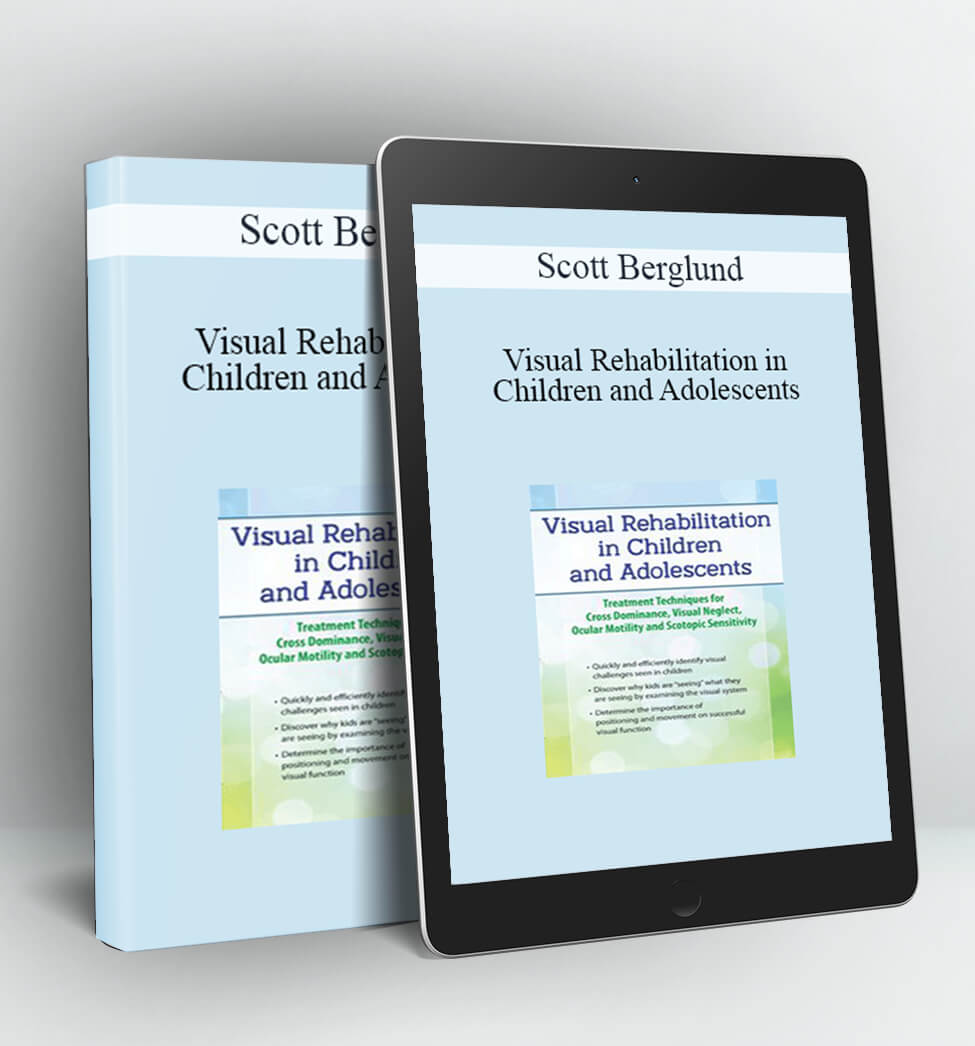VISUAL REHABILITATION IN CHILDREN AND ADOLESCENTS: TREATMENT TECHNIQUES FOR CROSS DOMINANCE, VISUAL NEGLECT, OCULAR MOTILITY AND SCOTOPIC SENSITIVITY – SCOTT BERGLUND
Over the past 40 years, the genetic predisposition to visual problems has not changed. However, due to society’s sedentary lifestyle, unregulated TV viewing, excessive video game play, and poor computer habits, more and more children are demonstrating visual challenges at home, at school, and at play.
This recording is designed to help professionals understand common visual problems in children (0-21 years old), what children are “seeing,” why they are seeing it, and how to fix these visual challenges. Combining research-based lecture and interactive labs, this course provides attendees the proper tools to identify and treat visual neglect, cross dominance, eye teaming, visual processing, and scotopic sensitivity. Correcting these issues ultimately improves the child’s quality of life, as reading, handwriting, and playing are enhanced.
Grounded in evidence-based information, this recording offers comprehensive coverage of established techniques that can be implemented immediately and effectively in therapy, at home, and in the classroom.
- Recognize the anatomy of the visual system in relation to the motor and auditory systems and how they work together to affect and rehabilitate visual issues.
- Determine functional movement, reflexes, and righting reactions and the influences on reading, handwriting, and play.
- Identify quick and easy ways to detect visual challenges in a child through his or her productivity and functional responses in various locations.
- Implement the treatment for parallel pathway learning by utilizing movement and balance.
- Discover positioning and its effect on visual processing, focus, eye teaming, and hand-eye speed.
- Demonstrate researched based visual rehabilitation techniques for unilateral neglect, visual perceptional challenges, ocular conditions, scotopic sensitivity and cross dominance.
ANATOMY OF THE VISUAL SYSTEM
- Pathway of sight
- Parallel pathways and the LGN
- Parvocellular retinal ganglion cells
- Magnocellular retinal ganglion cells
- Pathway overlap and short circuits (Dyslexia Theory)
- Parallel pathways and the LGN
- Primary visual areas
- Secondary visual areas
- Interpretation of these areas
VISUAL-MOTOR INTEGRATION IN THE BRAIN
- Primary motor pathway
- Cortical interactions between the motor system and the visual system
- Secondary visual area interaction
POSITIONING, MOVEMENT, & THE EFFECTS ON VISION
- Reflexes: acquiring visual-motor control
- Righting reactions: proprioception, vestibular, and visual system interaction
- Pelvic girdle: power, visual awareness, and alertness
- Shoulder girdle: head and neck control, ocular motor activation
CROSS DOMINANCE: WHEN HAND DOMINANCE & EYE DOMINANCE DON’T MATCH
- Defining and identifying cross dominance
- Why do we have a dominant eye when half of each eye has control?
- Directionality and play issues
- Handwriting issues
- Reading challenges
- Treatment techniques and relationship to the brain
- Lab
- Discrimination training
- Vertical midline activities
UNILATERAL VISUAL NEGLECT
- Definition of neglect and the identification
- Issues during play, work, and school
- Handwriting clues associated with visual neglect
- Environmental adaptions
- Treatment techniques
- Lab
- Reflex training
- Midline exercises
EYE TEAMING TRACKING & SACCADES
- Musculature of the eye
- What do problems look like?
- When should I treat and when should I refer?
- Reading problems
- Handwriting problems
- Gross motor problems
- Orthopedic pelvic dysfunctions
- Training and lab
- Focus/refocus exercises
- Motor system treatments
- Reading training
VISUAL PROCESSING
- Understanding visual processing
- Visual spatial relations
- Visual figure ground
- Effects on handwriting
- Reading challenges
- Treatment techniques
- Lab
- Space-moment and cortical learning
- Relationship to saccades and eye teaming
SCOTOPIC SENSITIVITY & ITS SECONDARY EFFECTS
- Definition and theory
- Effects on visual pathways and secondary visual areas
- Treatment techniques and effect on visual spatial relations, tracking, and scanning
- Case study
Tag: Visual Rehabilitation in Children and Adolescents: Treatment Techniques for Cross Dominance, Visual Neglect, Ocular Motility and Scotopic Sensitivity – Scott Berglund Review. Visual Rehabilitation in Children and Adolescents: Treatment Techniques for Cross Dominance, Visual Neglect, Ocular Motility and Scotopic Sensitivity – Scott Berglund download. Visual Rehabilitation in Children and Adolescents: Treatment Techniques for Cross Dominance, Visual Neglect, Ocular Motility and Scotopic Sensitivity – Scott Berglund discount.





